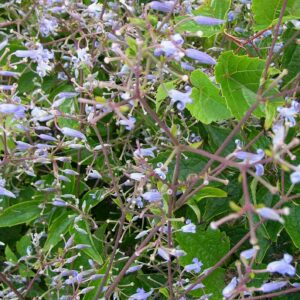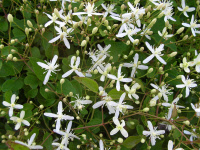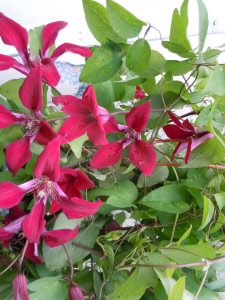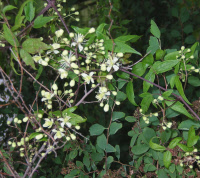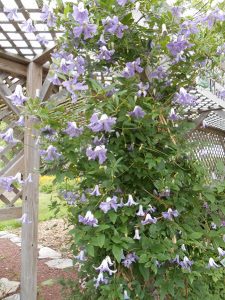Shop
Showing 193–200 of 788 results
-
Clematis recta ‘Purpurea’ Ground clematis, Flammula clematis POISONOUS Z 3-9
Fragrant star-shaped white blooms May-July on attractive purple foliage, fading to green by mid-summer.
ARCHIVED
Note: This is a plant not currently for sale. This is an archive page preserved for informational use.
Fragrant star-shaped white blooms May-July on attractive purple foliage, fading to green by mid-summer. Can be trained to climb or left as a groundcover. Handling plant may cause contact dermatitis or allergic reaction
Size: 3-5' x 2-4'
Care: sun to part shade with moist well-drained soil. Pinch back buds to maintain purple foliage longer-when plant blooms foliage fades to green.
Native: Eastern, southern and central Europe.
Wildlife Value: attracts hummingbirds, butterflies & bees; Deer and Black Walnut tolerantRecommended for its purple foliage in The Gardens of Gertrude Jekyll.
-
Clematis stans Japanese clematis Z 4-8
soulful blue starry nodding bells
OUT OF STOCK
Fragrant, smelling of sweet violets, soulful blue starry nodding bells with petals that flip up at the ends (recurved) Blooms August – September. Ships only in spring
Size: 30" x 24"
Care: sun to part shade in moist well-drained soil
Native: JapanStans means “upright” as this is a bush, rather than a vine. (OK, we’ve put this in the vine category and it’s not a vine. But most people think of Clematis as vines and we didn’t want you to miss it.) In Japan called “Kusa-botan.” Collected by Ernest Henry ‘Chinese’ Wilson before 1910.
-
Clematis tangutica Russian virgin bower Z 4-9
Small yellow flowers bloom for months
OUT OF STOCK
Small yellow flowers bloom for months, from July to September, then turn into ornamental spidery seed heads.
Size: 15-20’ x 6-10’
Care: Sun - part shade in moist well-drained to well-drained soil. Prune close to the ground in spring.
Native: NW China and TurkestanThe genus Clematis was named by Dioscordes, physician in Nero’s army, from klema meaning “climbing plant.” Sixteenth century English herbalist John Gerard called Clematis “traveler’s joy” because of the joy given to travelers by the beauty of the flowers. This species, C. tangutica introduced to western cultivation in 1898 when it was sent to Kew Gardens from St. Petersburg, Russia, after its discovery in Tibet.
**LISTED AS OUT OF STOCK BECAUSE WE DO NOT SHIP THIS ITEM. IT IS AVAILABLE FOR PURCHASE AT OUR RETAIL LOCATION.
-
Clematis ternifolia Sweet Autumn clematis Z 4-8
Fragrant, small white blossoms smother this vigorous vine
Fragrant, small white blossoms smother this vigorous vine in September and October.
Can not ship to: Alabama, Delaware, Florida, Georgia, Maryland, Nebraska, New York, North Carolina, South Carolina, Tennessee and Virginia.
Size: 15-20’ x 6-10’
Care: Sun moist well-drained soil mulched. Flowers on current year’s wood. Cut back in early spring to 6-8” above the soil.
Native: JapanThe genus Clematis was named by Dioscordes, physician in Nero’s army, from “klema” meaning climbing plant. In 1877 seeds of this vine sent from Russia to the Arnold Arboretum in Boston, then distributed to nurseries throughout America.
-
Clematis texensis ‘Gravetye Beauty’ Z 5-9
Small crimson-red bells dangle from July to September
Small crimson-red bells dangle from July to September
Size: 8’ x 3’
Care: Sun in humusy, fertile, moist well-drained soil. Mulch around the base. Flowers on current year’s stems so cut back to 6-9” in late winter or early spring.The genus Clematis was named by Dioscordes, physician in Nero’s army, from “klema” meaning climbing plant. The species 1st collected by the “Father of Texas botany,” Ferdinand Lindheimer in 1830’s. Max Leichtin of the Baden Garden sent Clematis texensis to Kew Botanic Garden near London in 1880’s. French nurseryman Francisque Morel sent this selection to William Robinson who named it for his English nursery at Gravetye Manor in 1914.
-
Clematis virginiana Virgin’s bower, Devil’s darning needles Z 4-8
July-September star-like white blossoms
July-September star-like white blossoms cover this vine – good for clambering up small trees.
Size: 12-20’ x 4’
Care: Sun to shade moist well-drained soil. Flowers on new stems so cut back in late winter or early spring to 6-8” above the ground.
Native: Nova Scotia to Georgia and as far west as Kansas, Wisconsin nativeThe genus Clematis was named by Dioscordes, physician in Nero’s army, from “klema” meaning climbing plant. One of 1st No. American plants sent to Europe – grew in Tradescant the Elder’s South Lambeth nursery in 1634. Grown by Jefferson at Monticello in 1807. Described by Breck in his 1851 book The Flower Garden: “The flowers are white borne upon cymes, and make a handsome appearance.” Cherokee mixed this plant with milkweed to remedy backaches. A root extract cured stomach aches, nervous conditions and kidney ailments. For the Iroquois powdered root fixed venereal disease sores and an extract of the stem brought on strange dreams. Pressed specimen in Emily Dickinson’s herbarium.
-
Clematis viticella ‘Betty Corning’ Z 3-9
Pendulous lavender trumpets
Pendulous lavender trumpets with bodacious flares bloom profusely, blooming machine all summer into fall.
Size: 8-10’ x 8’
Care: sun to shade in moist well-drained soil. Prune back to 1’ above ground in early spring.
Awards: Elisabeth Carey Miller Botanic Garden Great Plant Pick; Cary Award Distinctive Plants for New England; and England’s Royal Horticultural Society Award of Garden Merit.Selection of a cross between Clematis crispa and C. viticella, made in 1932 by Betty Corning.
-
Clematis x durandii Z 5-9
Big blue flowers from June to September
Big, deep indigo saucers – all summer into fall. The best short Clematis.
Size: 3-6' x 3'
Care: Full sun in moist well-drained to well-drained soil Prune back to a few inches above the ground in April. Needs staking or let it sprawl.
Awards: Elisabeth Carey Miller Botanical Garden Great Plant Pick.Cross of C. integrifolia and C. x Jackmanii, of garden origin. Hybrid from Durand in Freres France in 1874. William Robinson, father of mixed perennial borders, called this “effective and free.” (1933)


